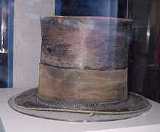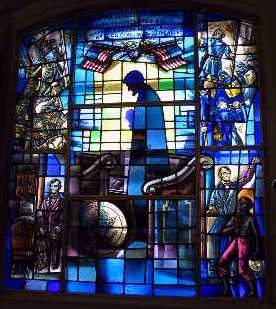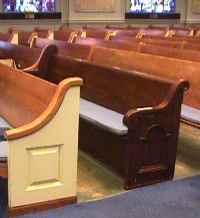Home | News | Books | Speeches | Places | Resources | Education | Timelines | Index | Search
© Abraham Lincoln OnlineNew York Avenue Presbyterian Church
1313 New York Avenue NW
Washington, D.C.Amid busy downtown traffic stands a Washington church with strong ties to the Lincoln family -- a must-see for anyone interested in the Lincoln story. President and Mrs. Abraham Lincoln first visited the New York Avenue Presbyterian Church shortly after he took office on March 4, 1861, and often attended services until his death on April 15, 1865. Located three blocks from the White House, the building was new when the Lincolns walked through the doorway.
Architect Edward Haviland designed the church in the Colonial Revival style with Italianate details. The steeple, then the tallest in the city, later was destroyed in a storm and rebuilt through the generosity of Mary Harlan Lincoln, widow of the president's son Robert. In 1951 this building was demolished and replaced with a similiar structure; the tower was dismantled and rebuilt.
Outside you can see the president's hitching post and the Lincoln Memorial Tower with its belfry and four-sided clock. The bells were a gift to the church in 1929 from Mary Lincoln Isham, one of Lincoln's granddaughters. The largest bell bears an inscription in the president's memory. Inside the church you will discover the family pew, a Lincoln stained glass window, an early emancipation document, and other memorabilia.
The congregation which welcomed the president's family was a blend of two groups: the Second Presbyterian Church and the F Street Associate Reformed Presbyterian Church. The Second Presbyterian Church owned a small building on the 14th Street site which made way for the new building; members of the F Street Church, who met a few blocks south of it, sold their building to the Willard Hotel. The Second Presbyterian Church attracted familiar figures such as John Quincy Adams, James Buchanan, John C. Calhoun, and Andrew Jackson. During the Lincoln era regular attendants at the New York Avenue church included Edward Bates and Simon Cameron of Lincoln's cabinet, Joseph Henry of the Smithsonian Institution, Senator Orville Browning of Illinois, and Mathew Brady of photographic fame.
Elizabeth Vincent, who lived across from the church, recalled seeing the Lincolns arrive for services. "When his modest carriage drew up at the entrance to the church, a group of curious or admiring spectators awaited his arrival, and the church was invariably thronged." The Lincoln children consisted of Robert, then away at college, as well as Willie and Tad, who were enrolled in Sunday School. The youngest sons also attended the Fourth Presbyterian Church occasionally with their friends Bud and Holly Taft.
The Lincolns sometimes picked up their old friend Senator Browning enroute to church or returned with him to the White House. William Crook, assigned to guard President Lincoln starting in January 1865, said the Lincolns also walked to the church. When they arrived, the congregation stood until they took their seats, but after the service this formality melted away and they left slowly, greeting people along the way.
© Abraham Lincoln OnlineThe Lincoln Family Pastor The Rev. Phineas D. Gurley, D.D., a graduate of Princeton Theological Seminary, assumed the pastorate of the F Street Church in 1854 and served the merged congregation until his death in 1868. Dr. Gurley aligned himself theologically with Old School Presbyterianism and its emphasis on traditional Calvinistic teaching. When he met the Lincolns in early 1861 he was the U.S. Senate Chaplain and loyal to the Union cause. It's likely he never imagined he would provide pastoral care following their son's death and the president's assassination.
Although the Lincolns did not join the church, they attended regularly and developed a cordial relationship with Dr. Gurley and his family. The Lincolns invited the Gurleys to dinner at the White House and attended the 1861 wedding of Mary Frances Gurley, with the president assisting in the receiving line. Mary Lincoln occasionally sent gifts to the Gurleys, including some valuable mementoes.
When the much-loved 11-year-old Willie Lincoln died on February 20, 1862, Dr. Gurley preached the funeral sermon in the White House East Room. A news story described Willie as "a fine looking boy, and his intelligence and vivacity made him a favorite with old and young. He was a faithful attendant of Sabbath school at Dr. Gurley's church, and the last day he was present there told his tutor that when he attained manhood he wanted to be a school-teacher or a preacher of the gospel." As he lay dying, Willie bequeathed his savings to the Sunday School, and at the next month's congregational meeting Dr. Gurley reported his $5.00 gift. In appreciation for Dr. Gurley's ministry during their grief the Lincolns gave him a special gold-headed cane.
After President Lincoln was shot on April 14, 1865, his family sent for Dr. Gurley, who arrived at his bedside early on April 15. When he returned home six hours later he said, "I felt as though I had been engaged all night in a terrible Battle and had but just strength enough left to drag myself off the field." Dr. Gurley spent most of his time trying to console the president's frantic wife; when death came he prayed by the bed and escorted Mary Lincoln back to the White House. There a harder task awaited him: announcing the sad news to young Tad Lincoln, whose profound grief moved him to tears.
Dr. Gurley played a more public role during the subsequent memorial services, delivering the sermon at the White House state funeral on April 19, and conducting the private service at the U.S. Capitol afterwards. Before Lincoln's coffin left for the railroad station, he offered prayer in the Capitol Rotunda, and more prayer just before the funeral train left. Then he embarked the train for the long trip to Lincoln's hometown of Springfield, Illinois, where he closed the burial services with prayer and a hymn he composed enroute.
© Abraham Lincoln OnlineMary Lincoln demonstrated her affection for Dr. Gurley when she sent him the late president's tall hat. In a May 22, 1865 letter she wrote of "the very kind regard entertained for you by my Beloved Husband." She closed with her thanks: "If anything can cast a ray of light across my dreary and blighted pathway, the recollection of your Christian kindness, extended to myself and family in our heavy bereavements will ever be most gratefully cherished." In 1868 Dr. Gurley died and the hat went to his heirs, who lent it to a museum display. When they tried to regain ownership years afterward they failed, despite a court battle. Today the hat is a star attraction at the National Museum of American History in Washington where thousands of visitors see what Mrs. Lincoln called "a precious relic." The Church After the Assassination
The day after President Lincoln died was Easter Sunday, usually the most joyful day on the church calendar, yet as Washington residents streamed into their churches, the gloom was unmistakable. A member of Lincoln's church noted in her diary, "The sorrow for the President's death is deep and universal as we went to church yesterday we found all the houses draped in black." A visitor at the church recalled, "His pew was draped in mourning, but every other was crowded and hundreds were unable to enter the house at all. The performances were very solemn and interesting."
Newspaper reporters, recognizing an opportunity, joined the congregation that day. One noted, "The church was very appropriately and tastefully draped with black alpaca, the white marble pulpit, covered with the same material, contrasting mournfully with the white linen overlaying the emblems of the Sacrament of the Lord's Supper, for the administering of which the day had been specially assigned. One unoccupied space, near the centre of the church, alone remained to impress upon the minds of all the reality of the nation's loss -- the untenanted pew of the late President, with its heavy fringe of deep black, mournfully eloquent."
True to his Reformed focus on the sovereignty of God, Dr. Gurley "urged the audience to look beyond the hand of the assassin to the hand of the wise God who overrules all things, and makes even the wrath of man to praise him. He admitted the soreness of this affliction, but doubted not that time would show God's purpose in bringing it upon us."
On June 1, 1865, the national day of mourning for President Lincoln, Dr. Gurley preached a sermon at the church titled "The Voice of the Rod." Based on Micah 6:9 ("Hear ye the rod, and who hath appointed it"), Dr. Gurley likened the assassination to God's chastening rod of correction. He lamented, "What a sore and sudden bereavement we have recently been called to bear! God speaks to us as He never spoke before. Let us study the lessons He is teaching us, study them prayerfully, and lay them to our hearts."
With Lincoln's death, the speculation about his eternal state intensified. His friends and colleagues held widely varying opinions, but some members of his church counted him as an authentic Christian believer. Dr. Gurley reportedly was the source for this position, saying that Lincoln intended to make a public profession of faith. When Lincoln's son Robert was questioned about Gurley's remark he expressed doubt but admitted, "it would be quite impossible to doubt the sincerity of an utterance of his if its authenticity was established."
© Abraham Lincoln OnlineThe Lincoln Stained Glass Window You will find the Lincoln Window along the north side of the church at the balcony level. Dedicated in 1970, it was the gift of Commodore and Mrs. Herbert C. Ruckmick in memory of their parents. It shows the president standing beside his pew during the pastoral prayer, as was his custom. The son of Mathew Brady, the famous Civil War photographer, recalls that both his father and Lincoln stood up during prayer time as a sign of respect and reverence.
The window's central theme is clearly Lincoln's dependence on divine help during his war-plagued administration. The Federal flags and eagle at the top center unite the opposing armies depicted at the right and left sides. A fragment from his Second Inaugural Address appears above all: "With malice toward none, with charity for all, with firmness in the right as God gives us to see the right." At the bottom left the president is shown seeking counsel from Dr. Gurley; at the right, he is helping to free the slaves.
The Lincoln Chapel and Parlor
The Lincoln Chapel, on the lower level beneath the front of the sanctuary, is used today for classes and small gatherings. It is in a similar location to the old church's assembly room where mid-week services took place. Adjacent is the Lincoln Parlor which contains furniture from the 1860s, including seats the president used when he listened unseen to mid-week services from the privacy of the pastor's study.
On the parlor wall you may see one of the church's most prized possessions: an early emancipation document signed by Lincoln on July 14, 1862, a week before he read the Preliminary Emancipation Proclamation to his Cabinet. Addressed to members of Congress, the preface reads: "Herewith is the draft of a Bill to compensate any State which may abolish slavery within it's limits, the passage of which, substantially as presented, I respectfully, and earnestly recommend." In 1953 the church received the document as a gift from Barney Balaban, then president of Paramount Pictures.
© Abraham Lincoln OnlineThe Lincoln Pew As they had done in Springfield, Illinois, the Lincoln family rented a pew in Washington, a customary means of supporting the church at the time. Many years later a church member recalled "taking the plan of the church pews over for inspection. Mrs. Lincoln looked it over and selected the pew which happened to be the one Mr. Buchanan had just vacated. The annual rental of the pew at that time was $50." This account differs from a June 6, 1861, newpaper article stating that the previous renter was Lewis Cass, not President Buchanan.
Today you will find the pew in the same approximate place as it was in the 1860s. Visitors are allowed to sit in it, but if you are as tall as President Lincoln, it could feel uncomfortable. A church member recalled, "Owing to its construction, President Lincoln seemed to be always ill as ease, finding much apparent difficulty in accommodating his tall frame to its meagre proportions."
The pew narrowly escaped destruction in 1886 during a church renovation. John D. McChesney discovered it outside in a pile of old pews destined for the dump. Fortunately the Lincoln pew had a silver plate identifying it, which is still visible today. In 1893 after the pew had been in a classroom several years, church members decided to return it to the sanctuary. The pastor, Dr. William Bartlett, concurred effusively: "It would be to me an inspiration. There is no greater religious relic in the world, and no greater relic anywhere than this pew where Abraham Lincoln sat to worship his God."
When the church celebrated its centenary in 1903 President Theodore Roosevelt and Secretary of State John Hay sat in the Lincoln pew. Hay, who had been on Lincoln's White House staff, recalled: "Some of you, I am sure, share with me the memories to which this occasion and place give rise, of the days when I have sat in this church with that illustrious patriot whose fame even now has turned to something remote and legendary. But whatever is remembered or whatever lost, we ought never to forget that Abraham Lincoln, one of the mightiest masters of statescraft that history has known, was also one of the most devoted and faithful servants of Almighty God who has ever sat in the high places of the world."
Visiting Information
For directions to the church, as well as parking and public transportation information, click here.
Related Links
Lincoln's Faith in God (Great American History)
Lincoln in Washington
New York Avenue Presbyterian Church History
Seeking God's Will: President Lincoln and Rev. Dr. Gurley (JALA)Related Reading
Edgington, Frank E. A History of the New York Avenue Presbyterian Church. Washington: New York Avenue Presbyterian Church, 1961.Guelzo, Allen C. Abraham Lincoln: Redeemer President. Grand Rapids: William B. Eerdmans Publishing Co., 1999.
Jones, Edgar DeWitt. Lincoln and the Preachers. New York: Harper & Brothers, 1948.
Temple, Wayne C. Abraham Lincoln: From Skeptic to Prophet. Mahomet, Illinois: Mayhaven Publishing, 1995.
Wolf, William J. The Almost Chosen People. Garden City: New York, 1959.
Home | News | Education | Timelines | Places | Resources | Books | Speeches | Index | Search Text and photos copyright 2020 by Abraham Lincoln Online. All rights reserved. Privacy Policy





